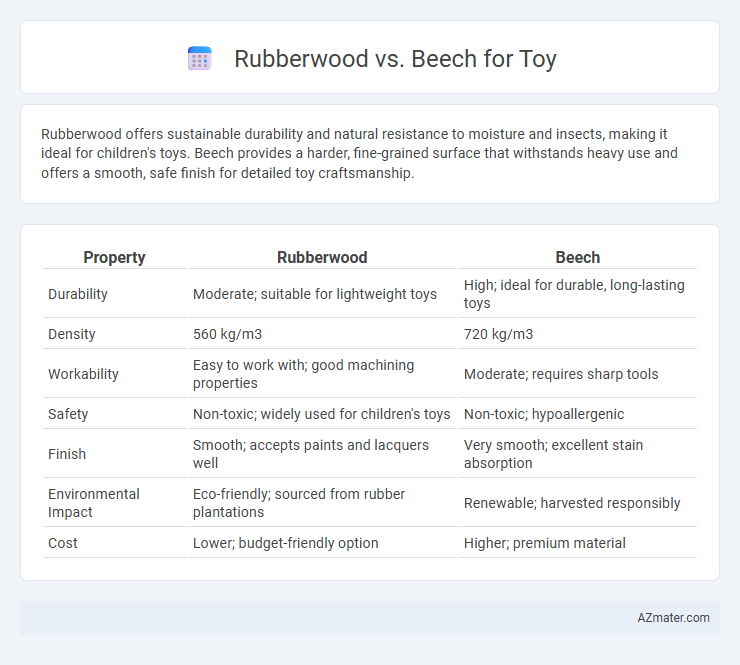Rubberwood offers sustainable durability and natural resistance to moisture and insects, making it ideal for children's toys. Beech provides a harder, fine-grained surface that withstands heavy use and offers a smooth, safe finish for detailed toy craftsmanship.
Table of Comparison
| Property | Rubberwood | Beech |
|---|---|---|
| Durability | Moderate; suitable for lightweight toys | High; ideal for durable, long-lasting toys |
| Density | 560 kg/m3 | 720 kg/m3 |
| Workability | Easy to work with; good machining properties | Moderate; requires sharp tools |
| Safety | Non-toxic; widely used for children's toys | Non-toxic; hypoallergenic |
| Finish | Smooth; accepts paints and lacquers well | Very smooth; excellent stain absorption |
| Environmental Impact | Eco-friendly; sourced from rubber plantations | Renewable; harvested responsibly |
| Cost | Lower; budget-friendly option | Higher; premium material |
Introduction to Rubberwood and Beech for Toys
Rubberwood, derived from the Para rubber tree (Hevea brasiliensis), is a sustainable hardwood favored for toy production due to its durability, light color, and resistance to warping. Beech, sourced from European beech trees (Fagus sylvatica), offers a fine, tight grain and exceptional hardness, making it ideal for toys requiring smooth finishes and high impact resistance. Both woods comply with safety standards for children's products, but Rubberwood's eco-friendly credentials and beech's robustness are key factors in material selection for toy manufacturing.
Sustainability and Environmental Impact
Rubberwood is considered a highly sustainable choice for toys due to its use of plantation trees that are harvested after latex production ends, reducing deforestation and waste. Beech, while durable and commonly used in toy manufacturing, often involves slower growth and higher environmental impact due to timber harvesting from natural forests. The carbon footprint of rubberwood is generally lower than beech, making it a more eco-friendly material option for environmentally conscious toy production.
Hardness and Durability Comparison
Rubberwood demonstrates a Janka hardness rating of approximately 960, offering moderate resistance to dents and scratches, while Beech exhibits a higher rating around 1,300, indicating superior hardness and durability. This hardness advantage makes Beech more suitable for toys that require extended wear and impact resistance. However, Rubberwood's natural resistance to moisture and affordability make it a practical choice for eco-friendly, lower-cost durable toys.
Safety and Toxicity Concerns
Rubberwood is often preferred for toys due to its low toxicity and sustainable sourcing, containing minimal harmful chemicals compared to other woods. Beech wood, while hard and durable, may sometimes be treated with finishes or adhesives that pose potential safety risks if not carefully regulated. Ensuring any toy-grade wood meets strict certifications like ASTM F963 or EN71 is critical to eliminate toxic exposure and guarantee child safety during play.
Appearance and Grain Patterns
Rubberwood features a pale cream to light brown color with subtle, straight grain patterns that create a smooth and consistent appearance, ideal for toy manufacturing. Beech wood offers a slightly pinkish to reddish tone with a fine, tight grain exhibiting occasional waves or curls, providing a richer and more decorative finish. Both woods are durable, but Rubberwood's uniform grain enhances a modern, minimalistic look, while Beech's varied grain adds warmth and visual interest to toys.
Workability and Crafting Benefits
Rubberwood offers excellent workability due to its light, fine-grained texture, making it easier to cut, shape, and sand, ideal for intricate toy designs and smooth finishes. Beech is harder and denser, providing superior durability but requiring more effort during crafting, suited for toys that demand longevity and resistance to wear. Both woods respond well to gluing and finishing, but Rubberwood's eco-friendliness and moisture resistance give it an advantage in safe, sustainable toy production.
Cost and Availability
Rubberwood is significantly more cost-effective than beech, making it a popular choice for toy manufacturing, especially in regions with abundant rubber plantations. Beech, though more durable and aesthetically pleasing, tends to be pricier and less readily available, often sourced from European or North American suppliers. The abundant availability of rubberwood in Southeast Asia ensures lower shipping costs and faster production times compared to the limited supply and higher expense of beech wood.
Maintenance and Longevity
Rubberwood offers excellent durability and requires minimal maintenance, making it ideal for toys that undergo frequent handling and occasional spills since it resists warping and cracking. Beechwood, known for its hardness and fine grain, demands more careful maintenance to prevent surface damage and maintain its appearance over time. Both woods provide long-lasting strength, but Rubberwood's natural resistance to moisture and pests often results in greater longevity for children's toys.
Popular Toy Applications
Rubberwood and beech are both popular choices for toy manufacturing, with rubberwood favored for its eco-friendly properties and affordability, making it ideal for budget-friendly educational toys and puzzles. Beech wood is commonly used in high-end wooden toys and dollhouses due to its hardness, smooth finish, and durability that withstands rough play. Both woods are non-toxic and hypoallergenic, ensuring safety in popular toy applications such as building blocks, stacking toys, and interactive learning tools.
Which Wood Is Better for Toys?
Rubberwood is better for toys due to its sustainability, durability, and smooth finish, making it safe and eco-friendly for children. Beech is also hard and durable but often more expensive and less environmentally friendly, as it takes longer to grow. The antimicrobial properties of rubberwood and its resistance to warping make it a superior choice for safe, long-lasting toys.

Infographic: Rubberwood vs Beech for Toy
 azmater.com
azmater.com